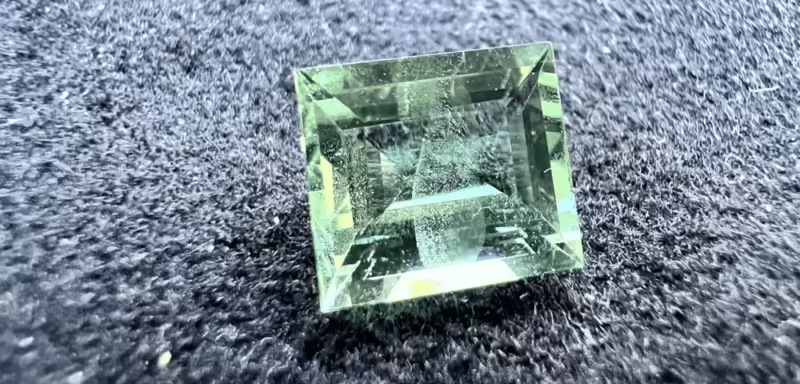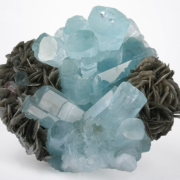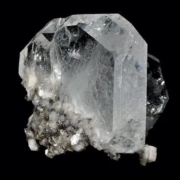Green beryl: Properties, Uses and Virtues
Green Beryl: In the Shadow of the Emerald
Green beryl, a member of the beryl family, captivates with its refreshing shades of green, ranging from delicate tones to deeper hues.
It is at the heart of the ongoing debate between gemologists over the very definition of an emerald and a green beryl, which are very difficult to differentiate.

Green Beryl: Table of contents
- Green Beryl Geological Formation
- Rough Green Beryl – Beauty in its Raw State Revealed
- Sources – The Global Scope of Green Beryl
- Historical Significance of Green Beryl – Through the Ages
- Metaphysical Properties of Green Beryl – Illuminating energies
- Varieties of Green Beryl
- Green Beryl Colors
- Durability and Wearability of Green Beryl
- Green Beryl Enhancements – Preserving Natural Beauty
- Synthetic Green Beryl – La Nature en Laboratoire
- Imitations of Green Beryl – Discerning the Genuine
- Caring for Green Beryl – Preserving natural beauty
Green Beryl Geological Formation
Green beryl, like other varieties of beryl, forms in veins of pegmatite within metamorphic and igneous rocks. Its geological formation involves complex processes of mineral interaction, intense heat and pressure that give rise to this captivating gem at the heart of the Earth’s crust.
Rough Green Beryl – Beauty in its Raw State Revealed
Rough green beryl crystals have the hexagonal shape characteristic of gems in the beryl family. The natural beauty of these crystals lies in their raw, unchanged state, where their refreshing shades of green are fully revealed in their pure, unaltered form.
Sources – The Global Scope of Green Beryl
Green beryl is found in different parts of the world, with notable sources including Brazil, Colombia, Madagascar and Russia. Each location contributes to the diversity of the green beryl’s color palette, making it a stone of fascination for artisan jewellers.
Historical Significance of Green Beryl – Through the Ages
Throughout history, the distinction between green beryl and emerald was not as clear as it is today.
Ancient civilisations, such as the Egyptians and Romans, considered many green stones, including green beryl and emerald, to be precious and valuable gems. They often used the term “emerald” generically to refer to any green stone.
The earliest known emerald mines were in ancient Egypt, dating back to at least 2000 BC. Cleopatra, the famous Egyptian queen, was known for her love of emeralds and used them in her jewellery and finery.
As gemmology and mineralogy evolved, distinctions were made between different green stones, and the specific chemical composition and trace elements responsible for the green color were identified. The name “emerald” has become more closely associated with intense green beryls containing chromium and, more recently, vanadium.
Today, gemologists and the gem trade make a clear distinction between green beryl and emerald based on their chemical composition and the presence of trace elements. Although green beryl is still valued as a beautiful gemstone, it does not have the same value and demand as genuine emeralds with their distinct green color caused by chromium and vanadium.
Note: some gemologists do not accept these definitions. Some note that an emerald is colored with chromium, and that any other trace element will give rise to a green beryl, including vanadium.
Others distinguish emeralds from green beryls by their color. Thus, an emerald colored with chromium or vanadium but showing a pale color would be designated green beryl.
Metaphysical Properties of Green Beryl – Illuminating energies
Green beryl is believed to have metaphysical properties associated with renewal, emotional healing and inner harmony. It is thought to bring a sense of tranquillity and balance to the wearer, promoting emotional well-being and a connection with nature.
Varieties of Green Beryl
Green beryl comes in different shades of green, each with its own unique charm and characteristics, but there is no specific variety as such.
Note: Some experts consider emerald to be a variety of green beryl, while others consider both emerald and green beryl to be a variety of beryl.
Green Beryl Colors
Green beryl has a refreshing palette of shades of green, from pale mint to vibrant emerald greens, although this is a matter of debate as noted earlier.
For many gemologists and experts, this definition differs. Some note that an emerald is colored with chromium, and that any other trace element will give rise to a green beryl, including vanadium.
Others distinguish emeralds from green beryls by their color. Thus, an emerald colored with chromium or vanadium but showing a pale color would be designated green beryl.
However, many people in the trade and some professionals consider an emerald to be any green beryl colored with chromium or vanadium, regardless of its shade.
As a general rule, green beryl is any light yellow to light green beryl, as well as any green beryl colored with iron.
Durability and Wearability of Green Beryl
Green beryl has good hardness, ranking from 7.5 to 8 on the Mohs scale, making it durable and suitable for a wide range of jewellery. Its resilience ensures that green beryl jewellery can withstand daily use while retaining its captivating brilliance. Green beryl also has fewer inclusions than typical emeralds and is therefore less fragile.
Green Beryl Enhancements – Preserving Natural Beauty
Improvements to green beryl, if any, vary according to each gemstone. It is possible to find stones that have been filled with fractures or oiled to improve their surface or clarity.
Some stones can be coated with the base to create a greener hue and make it look like an emerald.
Synthetic Green Beryl – La Nature en Laboratoire
Like other varieties of beryl, synthetic green beryl, or laboratory-grown green beryl, is created in a laboratory environment.
Although they share the same structural and optical properties as natural green beryl, synthetic versions offer a more affordable option for those seeking this captivating gem.
It is important to note that synthetic green beryl is less likely to be created than synthetic emeralds as they are created with the same process and material, but have a much lower value.
Imitations of Green Beryl – Discerning the Genuine
As a sought-after gem, green beryl can be imitated or counterfeited by any green material, from glass to cubic zirconia, spinel and triplets.
Buyers should be cautious, but as a general rule, emerald is much more imitated than green beryl, which is therefore more likely to be genuine.
Buying from reputable, certified gem dealers guarantees the authenticity of the gemstone.
Caring for Green Beryl – Preserving natural beauty
Caring for green beryl jewellery ensures that its timeless beauty will last a lifetime.
To preserve its brilliance, avoid exposing green beryl to aggressive chemicals or sudden temperature changes.
Gently clean the gemstone with mild soapy water and a soft brush.
Store green beryl jewellery separately to avoid scratches and potential damage.




Leave a Reply
Want to join the discussion?Feel free to contribute!